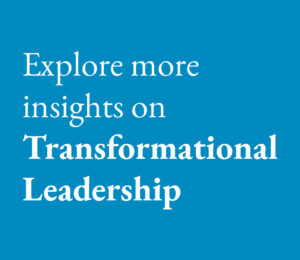The pandemic. Inflation. Supply chain disruptions. Social unrest. Wars. Any of these events would be enough to create a sense of vulnerability, uncertainty, complexity and ambiguity for business leaders. But all of them together? That feels more like chaos.
How do you navigate the uncertainty? How can you insulate your business from crises? How do you chart a path when the future is unclear? And how do you bring order to chaos when the old way of doing business no longer works?
Those questions are disrupting the practice of leadership, and they set the stage for the 2022 Insigniam Executive Summit. We brought together thought leaders from nearly every sector to explore how they can—and must—meet the challenges ahead. Here’s what they learned.
The Rise of Stakeholder Capitalism
Today, a successful company is one that is doing well by doing good for all of its stakeholders, not just those controlling the purse strings.
But navigating the new landscape can be difficult. Gone are the days of hard data, when balance sheets were made up of physical assets and the bottom line was all that mattered. Today, much of a company’s value is made up of intangible items, like intellectual property, brand equity and digital assets, and reputation trumps profit.
Also gone are the days when executives sat in ivory towers and managed from the relative safety and anonymity of the executive suite. Today’s executives are visible, vulnerable and, whether they like it or not, expected to take a stand on the issues of the day. For these executives, the success or failure of their company is sometimes just one tweet or viral video away.
 “The biggest problem with this movement toward stakeholder capitalism is this: If we’re human organizations with values … how can we be values-based and also stay out of counterproductive, destructive and polarized political battles?” said Alan Murray, CEO of Fortune Media and one of the keynote speakers at the Summit. “There is no easy answer.”
“The biggest problem with this movement toward stakeholder capitalism is this: If we’re human organizations with values … how can we be values-based and also stay out of counterproductive, destructive and polarized political battles?” said Alan Murray, CEO of Fortune Media and one of the keynote speakers at the Summit. “There is no easy answer.”
Mr. Murray, who has spent more than 40 years covering business and politics in the media, has seen a seismic shift over the last decade from the traditional, hierarchical form of leadership to a more transparent, relational leadership style. Stakeholder capitalism requires executives to better balance their attention between the interests of their shareholders and those of their stakeholders—customers, employees and even social media.
Raising the Bar for Leadership
Enter the reluctant activist CEO, someone who feels pressured into “taking public positions on environmental, social and political issues not directly related to their business.”
Human organizations are required to be more human. Therefore, today’s CEOs need to have values and opinions, and they need to stand for something besides profit and commerce.
“As an example, look at what McDonald’s did in Russia,” said Mr. Murray. “They spent three decades trying to break into that market, and they voluntarily chose to pull out, not because of sanctions but because it was the right thing to do. To see McDonald’s give up that business and lose substantial amounts of money because of principles is pretty extraordinary.”
The stakes are high, but then they’ve always been high. You can only put the company first for so long before you realize what benefits society benefits business, and vice versa.
“The best companies have always had a strong sense of purpose beyond profit and focused on a broad array of stakeholders,” Mr. Murray said. “The difference about the current environment is it’s not a choice anymore. You have to do this, and the economic forces in place mean you won’t succeed if you don’t.”
Success, whether globally or in your own backyard, depends on having an infrastructure that empowers everyone within the organization, from the C-suite to the back room, to follow through on the corporate commitment.
 “There’s a big disconnect between the intentions of many people running large corporations and what happens down on the ground,” Mr. Murray said. “The world moves too fast. You can’t wait for someone up at the top to tell you what to do. People have to be empowered at the edges.”
“There’s a big disconnect between the intentions of many people running large corporations and what happens down on the ground,” Mr. Murray said. “The world moves too fast. You can’t wait for someone up at the top to tell you what to do. People have to be empowered at the edges.”
Chantal Sarmanoukian, head of Strategic Sourcing and Procurement at the Bill and Melinda Gates Medical Research Institute, agreed. “CEOs and senior leaders are learning to listen to individuals who may not necessarily have the experience, but they have the forethought or insights to consider all of the voices—the customer as well as the organization itself.”
Is Neuroscience the Key to Better Business?
Few C-level executives would say neuroscience is one of their top business tools. But they should, according to Moran Cerf, Ph.D.
Our brain does a lot of things that drive our thinking and behavior, and we’re not fully aware of them,” said Mr. Cerf, neuroscientist and business professor at the Kellogg School of Management at Northwestern University.
“Neuroscientists are looking to explain not only how the brain works, but also the real-world applications.”
 Mr. Cerf said these three discoveries could alter the future of business:
Mr. Cerf said these three discoveries could alter the future of business:
1 | Memories are more malleable than we thought.
Every time the brain accesses a memory, that memory is permanently modified. This helps protect us from trauma by making bad memories less painful over time.
But it also makes us susceptible to outside influences (good or bad) that can change how we think and act.
Researchers have seen some success with erasing memories in animals, or even transporting them from one brain to another. “Everyone believes we can choose what we do and don’t want to put into our brain, but our memories and perceptions are just as vulnerable as other things,” Mr. Cerf said.
2 | Brains can find meaning in complex data.
Humans experience the world through five senses, but there’s more to the world than we can sense. That doesn’t mean we can’t develop new ways of interacting with the world. For example, people can be trained to better understand and act on data through a series of vibrations than with a paper chart or graph.
“The brain has the ability to find meaning in data in a fast, remarkable way that could solve problems for us in a way machine learning can’t,” Mr. Cerf said.
3 | Our brains can solve problems while we sleep.
While you sleep, your brain is still actively processing information. That’s not news. The breakthrough is that neuroscientists are learning how to read and write the contents of your dreams while you sleep, which could possibly influence behaviors or aid in problem-solving.
“One of the theories of dreams is that it’s a mechanism for simulating potential futures to see how we feel about them,” Mr. Cerf said. “When you make a choice, you may be bolder because you already have a feeling what the outcome will be.”
Featured Thought Leaders BIOS
Alan Murray has spent more than four decades covering business and politics for CNBC, The Wall Street Journal and Fortune Magazine. Today, he serves as CEO of Fortune Media, overseeing business and editorial operations. Murray also writes The Fortune CEO Daily blog and co-hosts the Leadership Next podcast. His latest book, Tomorrow’s Capitalist: My Search for the Soul of Business, was published in May.
Moran Cerf, Ph.D., is a neuroscientist and business professor at the Northwestern University’s neuroscience program and Kellogg School of Management. He is also a member of the Northwestern Institute on Complex Systems and the Alfred P. Sloan professor at the American Film Institute. Mr. Cerf studies the underlying mechanisms of psychology, emotion and decision-making. He holds multiple patents, is a Hollywood consultant, and has contributed to Wired, Time, Forbes, CNN, NPR and the BBC, among others.






